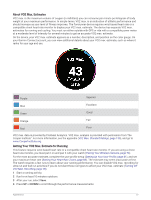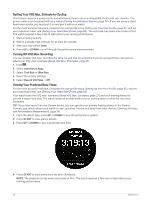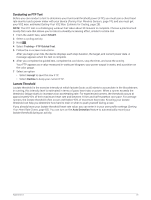Garmin Forerunner 955 Solar Owners Manual - Page 34
Performance Measurements, VO2 max., Predicted race times, HRV status, Performance condition
 |
View all Garmin Forerunner 955 Solar manuals
Add to My Manuals
Save this manual to your list of manuals |
Page 34 highlights
Performance Measurements These performance measurements are estimates that can help you track and understand your training activities and race performances. The measurements require a few activities using wrist-based heart rate or a compatible chest heart rate monitor. Cycling performance measurements require a heart rate monitor and a power meter. These estimates are provided and supported by Firstbeat Analytics™. For more information, go to www.garmin .com/performance-data/running/. NOTE: The estimates may seem inaccurate at first. The watch requires you to complete a few activities to learn about your performance. VO2 max.: VO2 max. is the maximum volume of oxygen (in milliliters) you can consume per minute per kilogram of body weight at your maximum performance (About VO2 Max. Estimates, page 27). Predicted race times: The watch uses the VO2 max. estimate and your training history to provide a target race time based on your current state of fitness (Viewing Your Predicted Race Times, page 28). HRV status: The watch analyzes your wrist heart rate readings while you are sleeping to determine your heart rate variability (HRV) status based on your personal, long-term HRV averages (Heart Rate Variability Status, page 29). Performance condition: Your performance condition is a real-time assessment after 6 to 20 minutes of activity. It can be added as a data field so you can view your performance condition during the rest of your activity. It compares your real-time condition to your average fitness level (Performance Condition, page 29). Functional threshold power (FTP): The watch uses your user profile information from the initial setup to estimate your FTP. For a more accurate rating, you can conduct a guided test (Getting Your FTP Estimate, page 30). Lactate threshold: Lactate threshold requires a chest heart rate monitor. Lactate threshold is the point where your muscles start to rapidly fatigue. Your watch measures your lactate threshold level using heart rate data and pace (Lactate Threshold, page 31). Stamina: The watch uses your VO2 max. estimate and heart rate data to provide real-time stamina estimates. It can be added as a data screen so you can view your potential and current stamina during your activity (Viewing Your Real-Time Stamina, page 33). Power curve (cycling): The power curve displays your sustained power output over time. You can view your power curve for the previous month, three months, or twelve months (Viewing Your Power Curve, page 33). 26 Appearance















